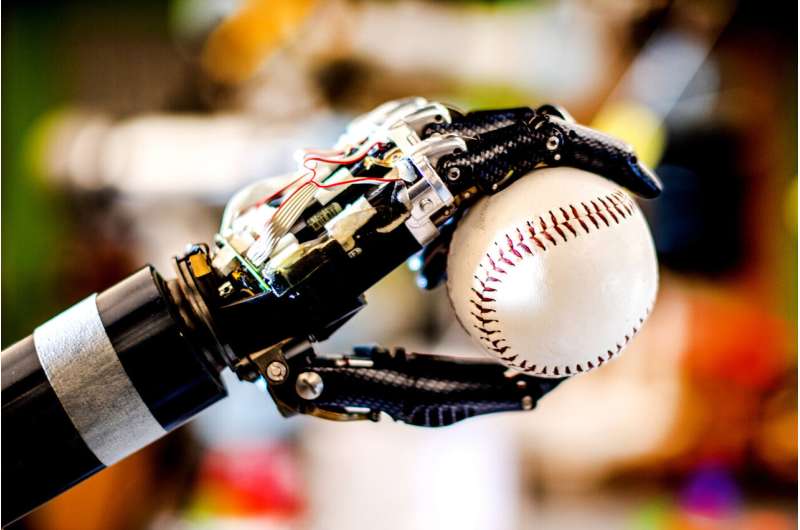Robot umpires are coming to baseball. Will they strike out?

Baseball fans know the bitter heartbreak of calls that don’t go their way—especially, a ball that should’ve been a strike. And, with advances in technology including computer vision, artificial intelligence, and the ubiquity of Wi-Fi, it would be easier than ever for baseball officials to replace humans with robotic umpires.
But as the high-stakes baseball World Series gets underway, the question is: Should they?
“The human element of officiating is one of the consistent inconsistencies that make sport a comprehensive human experience,” says Dan Lebowitz, executive director of the Center for the Study of Sport in Society at Northeastern, adding that widespread implementation of robot umpires could mean displacing the humans who have staked out livelihoods calling games—76 of them in Major League Baseball.
But perhaps the debate doesn’t have to be binary, Lebowitz says. Lots of leagues are already experimenting with “AI augmentation” when it comes to refereeing.
Take, for example, baseball’s Atlantic League, an independent circuit with teams on the East Coast and Texas. In 2019, it became the first American professional baseball league to let a robot umpire call balls and strikes, and it’s unlikely fans even knew.
During an All-Star game, home plate umpire Brian deBrauwere wore a Bluetooth-connected earpiece, connected to an iPhone in his back pocket that was connected to a software program in the press box. The software called balls and strikes, and communicated them to deBrauwere through his earpiece. If he didn’t like the call, he could simply overrule it, and call the pitch as he saw it.
The software allowed higher and lower strikes than a human would have normally called—a fact acknowledged by the players during the game who shook their heads at a couple of pitches, the Washington Post reported. But largely, it’s unlikely fans even noticed a difference.
And, says Kevin Esslinger, a doctoral candidate studying artificial intelligence and computer science, the technology to calculate exact balls and strikes is already in use—look no further than the superimposed strike zone box on any major television network—just not by the umpires.
Radar systems placed strategically throughout baseball stadiums can triangulate the exact position of a ball as it crosses home plate, giving anyone watching at home an instant read on whether it was a ball or a strike. Newer technology, including ultra-high speed cameras, is also used to calculate the point at which a baseball crossed the plate.
An algorithm that’s already in use in some autonomous vehicles could provide an even more exact answer, Esslinger says. Called YOLO (short for “you only look once”), the algorithm uses neural networks to deliver real-time object detection. Trained over time, the algorithm could learn to detect a baseball and determine whether it was within a set strike zone, calling perfect balls and strikes each time.
Fittingly, baseball already has a sacrosanct strike zone: “That area over home plate the upper limit of which is a horizontal line at the midpoint between the top of the shoulders and the top of the uniform pants, and the lower level is a line at the hollow beneath the kneecap,” according to the Major League Baseball rulebook.
“With umpires, there’s a lot of human subjectivity that goes into calling these plays,” Esslinger says. “I think we should always go with the correct call, and by that I mean, we can measure whether a ball is a strike—if a ball is in the strike zone, it should always be called a strike.”
But for Lebowitz, the decision to deploy robotic umpires is more complicated.
“The question remains whether the benefits of AI in sport outweigh the potential pitfalls that have arisen” in other instances where AI is in use throughout our lives, he says, noting the hacking exposure in an industry beset with big money in the form of betting and fantasy leagues.
It may be that the ball is already in motion, so to speak, though. And Lebowitz says we, the fans, stakeholders, viewers, owners, and players “will continue to dialog, debate, dignify, or decry the movement toward robotic reliance.”
Citation:
Robot umpires are coming to baseball. Will they strike out? (2021, October 28)
retrieved 28 October 2021
from https://techxplore.com/news/2021-10-robot-umpires-baseball.html
This document is subject to copyright. Apart from any fair dealing for the purpose of private study or research, no
part may be reproduced without the written permission. The content is provided for information purposes only.
For all the latest Technology News Click Here
For the latest news and updates, follow us on Google News.

